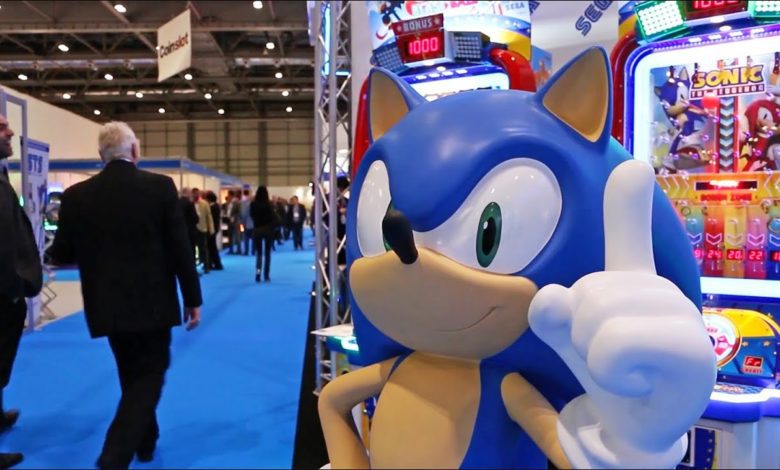
SEGA Nerds in Monster Lair

[Welcome to the second part of four in our series of Wonder Boy video game retrospectives! If you have not done so already, we would recommend giving part one a read. The first part covers the original Wonder Boy title along with its sequel, Monster Land. Both games will be referred to in this article, so be sure to brush up on your knowledge. Feel free to head on back here once you’re done!]
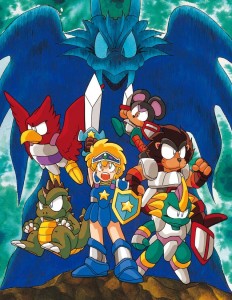 With two Wonder Boy games under their belt, it was time for Japanese development studio Westone to make a tough decision. What was the best direction to take the series? The fast paced side-scrolling action of the original Wonder Boy was a hit in the arcade and the gameplay fit nicely into the coin-op scene. The latter of their two titles, Monster Land, was much better suited to home systems. It featured RPG elements which added some extra depth to the game, such as talking with non-playable characters and purchasing / equipping items. This made for a lengthier adventure and one that requires a more complex thought process behind it if players wish to become victorious.
With two Wonder Boy games under their belt, it was time for Japanese development studio Westone to make a tough decision. What was the best direction to take the series? The fast paced side-scrolling action of the original Wonder Boy was a hit in the arcade and the gameplay fit nicely into the coin-op scene. The latter of their two titles, Monster Land, was much better suited to home systems. It featured RPG elements which added some extra depth to the game, such as talking with non-playable characters and purchasing / equipping items. This made for a lengthier adventure and one that requires a more complex thought process behind it if players wish to become victorious.
These were no doubt the same thoughts that ran through the heads of creators of the series Ryuchi Nishizawa and Michishisto Ishizuka. While neither of the previous titles had huge success, each had different play styles that many could enjoy. So, why not keep both? The next two Wonder Boy titles were developed very closely to one another. The first one was being built for arcades, focussing on the high speed gameplay that was so prominent in the original title. The second was being built for home systems, developing on the Monster World formula so that it expanded to a huge open world adventure.
Little did Westone know, the upcoming success of their fourth title would change the way they looked at the Wonder Boy series forever. Not counting Hudson’s Adventure Island, Monster Lair is the final Wonder Boy game in the series to use the original formula and it was also the last to grace arcades. It did still mix things up a whole bunch, but the traditional timer based runner style of play was still intact.
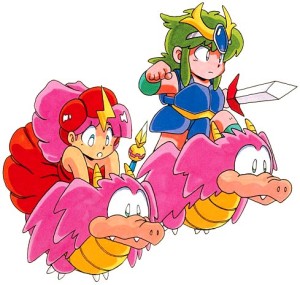 The following titles will be discussed in order of their release. Our first topic of discussion, Wonder Boy III: Monster Lair, was released in the arcade during 1988. The home console versions did not hit Japanese living rooms until 1989 (PC Engine) and 1990 (SEGA Mega Drive.) The second title, Wonder Boy III: The Dragon’s Trap, released for the 8-bit SEGA Master System in 1989. Unlike Monster Lair and all of the preceding Wonder Boy titles, it did not originate from the arcade. As you are no doubt about to find out, building a game with home systems in mind first and foremost certainly has its advantages!
The following titles will be discussed in order of their release. Our first topic of discussion, Wonder Boy III: Monster Lair, was released in the arcade during 1988. The home console versions did not hit Japanese living rooms until 1989 (PC Engine) and 1990 (SEGA Mega Drive.) The second title, Wonder Boy III: The Dragon’s Trap, released for the 8-bit SEGA Master System in 1989. Unlike Monster Lair and all of the preceding Wonder Boy titles, it did not originate from the arcade. As you are no doubt about to find out, building a game with home systems in mind first and foremost certainly has its advantages!
We will be ordering the two games going by the release date of Monster Lair in the arcade. Without further ado, let’s power up our swords and shoot down some cute but aggressive wildlife as we journey into…
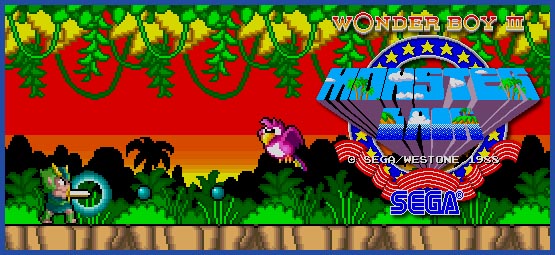
Wonder Boy III: Monster Lair released in Japanese arcades way back in 1988. The title was developed by Westone and was published by SEGA.
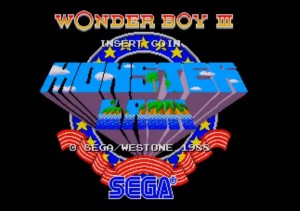
Players take the role of Leo, a green haired boy and Princess Purapril, a cute red / pink haired girl that wishes for nothing but peace throughout her kingdom. Fat chance of that happening any time soon princess, as an invasion of monsters is about to come raining down on the lands, sending the inhabitants into an wave of panic. Both brave children set out to protect the land, as clearly the kingdom is severely lacking in decent defences and inhabitants of basic intellect. Luckily for them, they are able to use the invaders technology against them, picking up their weaponry and powering up their own. It’s time to fight fire with fire!
Rather than expanding upon the Monster Land genre of game, Westone returned to the series roots, following in the footsteps of the original Wonder Boy title. There are many similarities here. Players are constantly running from the left to the right of the screen, racing against a continuously depleting timer. If the timer runs out, then the player loses a life.
Fortunately, fruit and other such edible goodies can be found scattered about the place, which extends the timer and grants players some valuable extra time. Certain fruit, if attacked enough times, will expand and split into many smaller pieces of the same type. This is a useful feature that makes filling your time bar back up to maximum a breeze. On the other hand, it can be difficult to successfully pull off as enemies will be drawing closer as you are focusing your efforts on attacking the fruit! Which will you choose, fight the enemies or collect more fruit? Decisions, decisions…
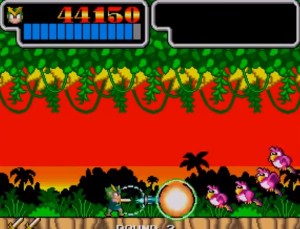
This time around one of the main gimmicks is the addition of co-operative play. Players can buddy up with a friend and take on hordes of agitated beasties as they blast their way through each round. The arcade cabinet features two joysticks and four buttons, a jump and a shoot button for both players one and two. The home console ports also brought this multi-player action into the living room, supporting two control pads. It’s not possible to damage your partner, as you will both be working together to wipe out incoming foes. This is certainly a good thing, as bullets can be seen bouncing around the screen at all times.
You read that correctly, bullets. Or rather, magical shots that are fired from both of the main characters weapons, which are a sword and a staff respectively. There are no stone hatchets to be found this time around, as the combat has been transformed into a side-scrolling run and gun. Players begin by firing simple energy spheres in whichever direction they may be facing. In a similar fashion to the arcade title Metal Slug, other weapon upgrades can be picked up throughout each round, upgrading fire power substantially. It wont be long until you’re hurling laser beams and flaming fire balls from all angles, exterminating any unsuspecting foe that may be unfortunate enough to cross your path.
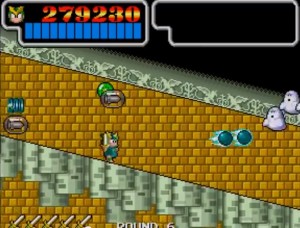
While it sounds out of place, the shoot-em-up style gameplay works better than one would expect. It keeps the action feeling fast paced and makes it much more enjoyable to wipe out large groups of enemies. With that said, it takes a lot of what made the original game so unique away from this sequel and enemies fly at you in predictable patterns. It is also too easy to accidentally pick up new weapon types. The platforming segments from the first title make an appearance here and more often than not, you will land a tricky jump only to accidentally pick up a new weapon. It can become a hindrance, as some are far more useful that others.
Weapons do not last forever though, as after a short period of time players will revert back to the original level of fire power. It’s then you will want to be hurriedly searching for upgrades, but the difficulty is never much of a problem that it isn’t possible to progress with only the basic shot. The game is much easier this time around, which can be seen as both a good and a bad thing. The timer is far more lenient and the fact you can bounce bullets around the screen makes powering through opponents a breeze. A lot of the annoyances from the first title are gone, such as the tiny rocks that could trip you up and the falling platforms that could make losing your footing incredibly easy. It feels like Monster Lair’s difficulty is a little too lacking however, especially when played in co-operative mode with players essentially having twice the fire power.
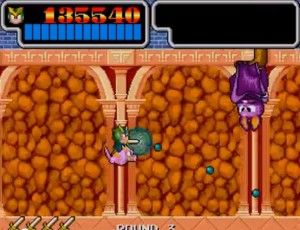
Each stage ends once players reach a deadly monster skull at the end of the round. After entering said skull, players are required to navigate through the lair of the monsters, taking out their leader who acts as the boss in each stage. These sequences are played exactly like a side-scrolling space shooter, with both Leo and the princess leaping atop of a friendly monster and flying through the lair. The control alters here, as players can now move up and down in addition to the usual left and right. The screen scrolls automatically as enemies are dodged and shot at using the fire power picked up from fallen foes.
The lair scenes are far too easy, especially when compared to other space shoot-em-up games of the time. It feels like a child’s version of Gradius and it just isn’t very fun. Enemy attack patterns are boring at best and the bosses are nothing to marvel at either. The first boss, a giant flying fish that shoots out smaller baby fish at the player, can be defeated in a matter of seconds even with the most basic fire power. The second boss, a giant snake, boasts some impressive visuals but once again can be defeated far too quickly if any of the stronger weapons are equipped.
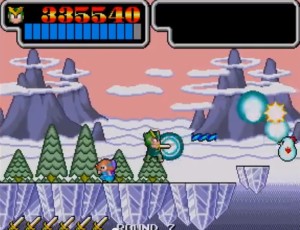
The only difficulty here comes from the games length. There are a total of fourteen rounds, each of which include two stages and a boss fight. While they are by no means difficult, each one takes a good few minutes to progress through leaving the total playtime at around an hour. While that is pretty good for an arcade title, it left a lot to be desired when ported to home systems. In all honestly, the game becomes tiresome very quickly, so we are actually quite grateful.
Monster Lair concludes with Leo and the princess discovering that the monster invaders had stolen the legendary equipment, which Tom-Tom so proudly fashioned in Wonder Boy in Monster Land. After defeating the leader of the monsters along with his giant flying dragon friend, Leo dons the legendary armour, holds his sword up high and peace is once again restored. Players are then treated with a horrendously Engrish epilogue before the credits roll and a final score is shown.
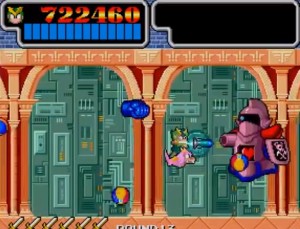
A couple of years later, the title was converted for home platforms and released on both the PC Engine and the SEGA Mega Drive. Only the PC Engine version released in North America, for what was over there known as the TurboGrafx-CD system. Interestingly, this home console port was handled by Hudson Soft. This was the same company that was granted the rights to the original Wonder Boy concept, developing their own series in the same style, named Adventure Island. It is clear that Westone and Hudson Soft’s business relations were still strong and it is likely that Westone approached them directly, asking them to handle the port.
After a less than desirable final trip to the arcades, Wonder Boy made his last bow to the coin-op scene and ventured forth to home consoles. It is there he was to remain for the foreseeable future and it wasn’t long until before the far more appealing gameplay of Monster Land made its triumphant return. It’s time to leave Leo and the princess behind and once again pick up our trusty sword and shield, head held high as we march forward into…
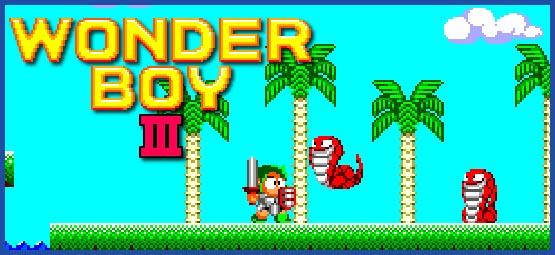
Wonder Boy: The Dragon’s Trap released in the United States for the SEGA Master System in 1989 and is a direct sequel to Monster Land.

Despite being developed in the east, the title did not hit the Japanese market until 1992 when it was released on the portable 8-bit system, the SEGA Game Gear. Westone went all out with this title, developing a large scale Monster Land style adventure with plenty of new gameplay mechanics to keep veteran fans interested. Gone is the timer and the redundant high score feature. The absence of these elements gives more time for exploration under less pressure, which is great when you consider how big the game world is this time around. Well, for an 8-bit title, at least!
The game begins with a fantastic opening sequence. Re-wind back to 1987 and recall the climax of Monster Land. The brave warrior Tom-Tom is storming the MEKA dragon’s lair in attempt to punch it clean into next week, stopping its evil schemes once and for all. The Dragon’s Trap throws players straight into this scene, music and all, as Tom-Tom navigates the (slightly easier) castle maze and heads straight into the dragon’s lair. After a perilous battle with the fiend, our little hero becomes victorious and saves all of the land from the monsters reign. Or, does he?
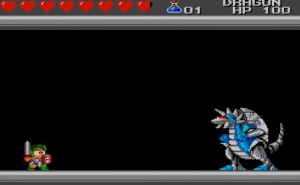
Suddenly, a terrifying curse appears from the remains of the beast and engulfs our hero. After a brief flash of light, the cute little warrior we have come to know and love is turned into a tiny green dragon! Before he can work out his head from his tail, the castle begins to collapse and players are thrown into a heart pounding escape sequence. After making his great escape and returning to safety, our dragon friend decides to get straight back into the action. If he is to regain his form, Tom-Tom must defeat the five dragon guardians and wipe out the monsters once and for all!
The Dragon’s Trap includes a big open world that branches off from a central town area. This soon to be series staple is a great game structure as it encourages exploration, requiring players to put their mind and dexterity to the test if they are to work out where the next dragon guardian lies. The central town itself is rather small, consisting of only a store and a hospital. There are plenty of branching pathways though, including some that are currently inaccessible to the player. After defeating a dragon guardian, a short-cut is created leading back to this small town and players are able to make use of newly acquired abilities to discover new pathways.
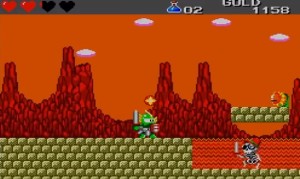
Each time the player defeats one of the five guardian dragons, a new form is taken on by Tom-Tom. After defeating the MEKA Dragon in the introduction sequence, our little friend becomes a small green dragon that shoots flames from his gob. Other abilities possessed by this form is the power to crouch down and to also wade through lava, which comes in handy later on in the game. Our favourite feature of the dragon is that his idle animation just makes him look fed up!
The second form is that of a tiny mouse. This makes attacking with your sword difficult as the range is much shorter. It is possible to make use of shields though, allowing players to block incoming projectiles. The advantage to playing as the mouse is that it is now possible to stick to certain walls, allowing Tom-Tom to defy gravity, casually strolling up vertical surfaces and sticking to ceilings! You know, just like all mice can.
![]()
The third form is a large piranha with legs. We think he looks a bit more like an armour clad lizard man from The Nameless City by HP Lovecraft, though. This form is essential for under-water romps as it allows the player to swim. A tap of the attack button while submerged bounces our hero upwards, allowing players to swim up previously inaccessible areas. Fourthly we have the most powerful form, with Tom-Tom transforming into the most ferocious of creatures, the lion. The lion stands tall and mighty, swinging his sword is a huge arc giving a greater attack reach.
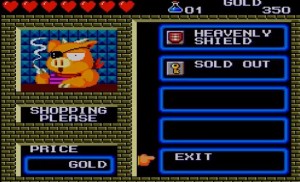
The fifth and final form is the hawk. As you would expect, this form allows for the player to soar through the air, flying high into the clouds. The drawback to this is that this form is the weakest of the lot and becomes damaged if exposed to water! Each of the five forms have their advantages and disadvantages and it is up to the player to put them through their paces, working out how to use each effectively.
It is disappointing you cannot switch between each form on the fly, but the decision Westone made here certainly has its advantages. Every time a new form is unlocked, players are required to jump around and discover what new abilities they now own. After working out said abilities, it is now time for them to be put into action, working out which section of the game world will now be traversable. It’s a rewarding system as each of the five different forms are unique and fun to play. Back-tracking is never a bind when you’re constantly on the look out for as to where you can put your new powers into action!
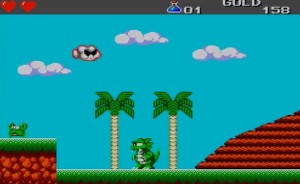
Along the course of your adventure, many different items and abilities can be collected. These are either bought from a store, scavenged from battle or picked up from inside an unlocked treasure chest. Similar to Monster Land, swords, armour and spells can all be equipped. Each have their own unique properties and will change the statistics of the player, which can be studied in the pause menu.
Each one of the spells is useful, with two of the best being tornadoes that attack enemies below you and arrows that are fired vertically to best foes above. Reaching all the way across to the Master System console and hitting pause every time you wish to switch is tiresome, but unfortunately it feels like a must if Westone was not to overcomplicate the controls.
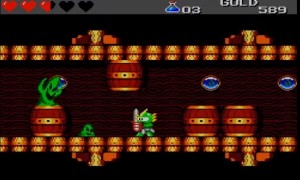
One interesting aspect of this game not present in the original is CP, which are what we like to refer to as cute points. This numerical statistic is determined by what form the player takes and the gear they have equipped. The higher the amount of cute points, the cheaper the items found in shops. It is a basic version of the speech ability found in many modern RPG’s. The only downside here is that it is not explained at all. Unlike the monster abilities, this definitely could have benefit from having a description, or at least a more appropriate name.
As the SEGA Master System control pad is limited to only two buttons, developing an action RPG title with special moves and abilities could not have been easy. Westone did the best with what was on offer and while the controls can take a little while to figure out, they soon become second nature.
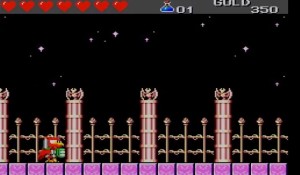
The directional pad moves Tom-Tom while buttons one and two allow for jump and attack, naturally. The pause button, which is located on the console itself, opens the menu screen where players can equip weapons, items and spells. To go through a door, the up button must be held on the directional pad for a couple of seconds. Firing magic is possible be holding down on the directional pad and pushing the one and two buttons at the same time.
It may sound confusing at first, but it only takes a couple of minutes to become accustomed to the way the game is played. The control for Tom-Tom is incredibly tight and it makes the precision platforming sections fun to navigate. Some of the abilities gained by the player, such as Mouse-Man’s ability to run along walls, can feel unclear at first. No hints are given in-game and the abilities rely on good old fashioned player ingenuity if they are ever to be discovered. We like it this way, as we feel too many games feel the need for constant hand-holding and direction rather than leaving it up to the player to experiment for themselves.
The Master System version of The Dragon’s Trap reviewed fairly well and sold even better. It did so well in fact that Westone never thought twice about changing the formula ever again. The game recieved cult success and it is today regarded as one of, if not the greatest title on the SEGA Master System. Gamers love The Dragon’s Trap and so do we.

While we do not hate Wonder Boy in Monster Lair, it certainly isn’t something to shout about. The gameplay is a huge step down from Monster Land and while the formula of the original title does better suit the arcade scene, we think that the added shoot-em-up elements felt too shoehorned into the experience. If you are a fan of the original Wonder Boy and the space shooter genre, then it is worth investigating Monster Lair and forming your own opinion.
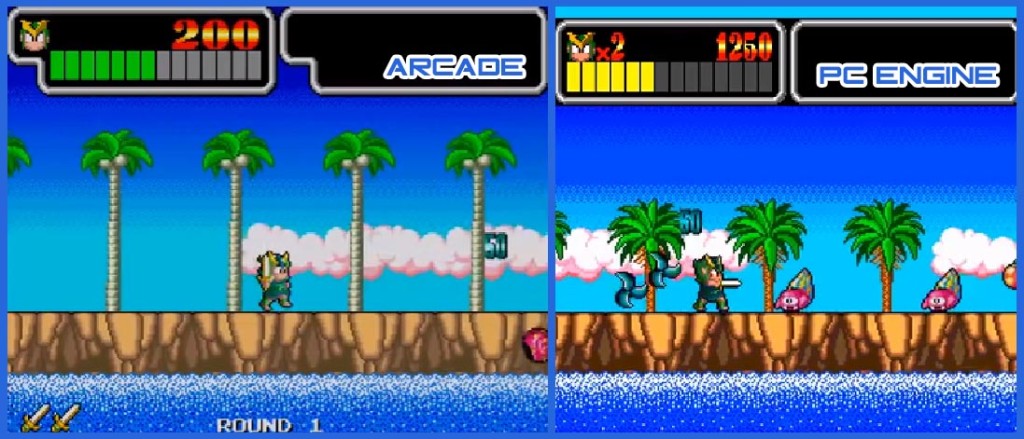
The PC Engine / TuroGrafx-CD version of Wonder Boy in Monster Lair is not bad, but it is far from a perfect port. It does features the co-operative gameplay of the original and even an entirely revamped soundtrack, but despite this certain other aspects of the game take a big hit. The sound effects, for example, are far more annoying than in the arcade original. The noises emitted from certain weapons grate against the ears and it will cause players to reach for the mute button or worse, abandon the game all together. There is plenty of sprite flickering going on too. This is especially apparent when combating boss monsters, since many enemies are on screen and lots of visual effects going on all at once.
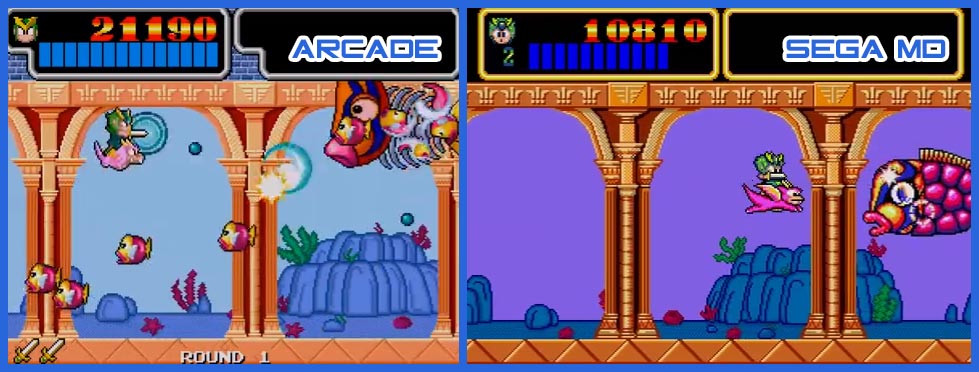
Thankfully, the SEGA Mega Drive version is a little better, but not by much. The graphics are far worse than the arcade original here, however they are still much nicer than the PC Engine version. Backgrounds are simplified and sprites are less detailed, although there is a degree of parallax scrolling going on in certain stages. The sound track is much closer to the original, as are the sound effects.
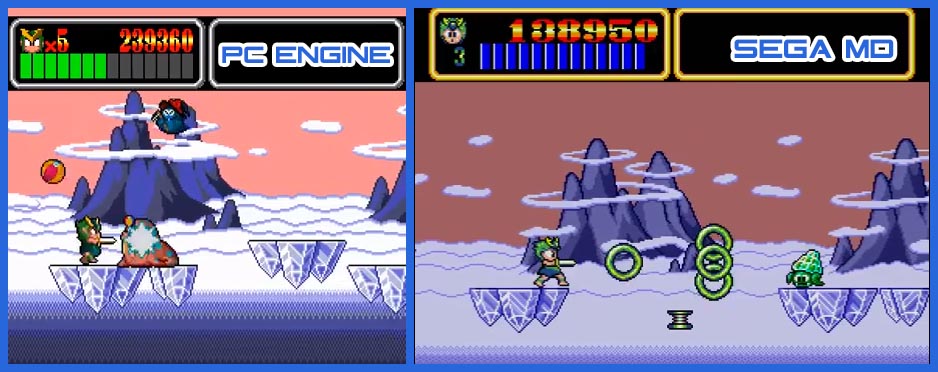
Out of the three, we would recommend giving the SEGA Mega Drive version a play as it is much easier to get a hold of and can be picked up from eBay at a low cost. The arcade version is no doubt the best here though, so if that is available to you then don’t think twice, give it a go!
The Dragon’s Trap is an excellent title and one of our favourite 8-bit games period. Westone pulled out all of the stops to create an exciting adventure, building upon the mechanics of Monster Land and adding a new spin on things with the monster transformations.
Developer Hudson Soft took their own spin on The Dragon’s Trap on the Japanese PC Engine and the American TurboGrafx-16 (as seen in the above video.) The title was confusingly named Adventure Island in Japan but Dragon’s Curse in the US. This is an excellent port and it is superior to the original in many ways. New graphics add extra detail to the character sprites and environment, while the revamped soundtrack actually sounds good this time around! The vibrant colours of the PC Engine really do the game justice and it runs great with little to no performance issues. Westone’s close partnership with Hudson Soft allowed for this timeless classic to make it onto other non-SEGA platforms and while we’re all about the big blue, we cannot help but be delighted that we are able to share the love.

While we at SEGA Nerds do enjoy both styles of Wonder Boy game, we admit that we are not too saddened on the companies new focus of turning Monster Land into its own franchise. It does feel harsh to make a direct comparison between both Monster Lair and The Dragon’s Trap, as they are very different games. It’s clear though that the latter certainly brings more to the table than the first and this is something that became apparent from its critical acclaim and good sales.
The side-scrolling shoot-em-up gameplay of Monster Lair fits the franchise better than I would have ever imagined. With that said, it still feels very sub-par when put up against other arcade shooters of the time and it does not feel like an aspect of the franchise that could have been developed upon much further.
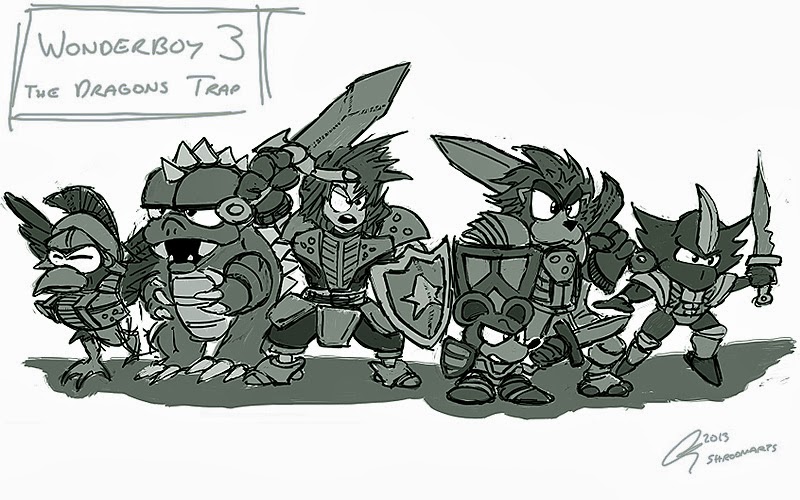
The Dragon’s Trap brings open world and more interesting gameplay mechanics to the series, including the character transformation ability. Just as Monster Land did before it with the addition of RPG elements, The Dragon’s Trap set the foundations for an open world next generation title from Westone. The critics wanted it, the fans needed it… and thankfully, Westone heeded their calls.
The days of the arcade boom were long gone and it was clear that home consoles were becoming the next big thing in video gaming. With the launch of SEGA and Nintendo’s next generation 16-bit consoles just around the corner, it was time to shift focus.

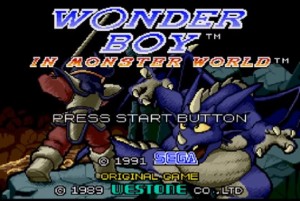
Monster World is back, this time bigger and better than ever! In the third part of our Wonder Boy retrospective we will take an in-depth look at the first 16-bit title in the series. A huge open world with many colourful characters awaits you in this exciting side-scrolling adventure game. Continuing the story from the previous title, Wonder Boy in Monster World tells the tale of a brave warrior named Shion as he seeks to become a hero, saving the world from the evil monsters that are running amok.
Do you have what it takes to earn the prestigious title of Wonder Boy? Join us next time in part three of our Wonder Boy retrospective and find out!

